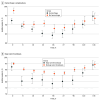Antithrombin III Levels and Outcomes Among Patients With Trauma
- PMID: 39145978
- PMCID: PMC11327888
- DOI: 10.1001/jamanetworkopen.2024.27786
Antithrombin III Levels and Outcomes Among Patients With Trauma
Abstract
Importance: Patients with trauma exhibit a complex balance of coagulopathy manifested by both bleeding and thrombosis. Antithrombin III is a plasma protein that functions as an important regulator of coagulation. Previous studies have found a high incidence of antithrombin III deficiency among patients with trauma.
Objective: To assess whether changes in antithrombin III activity are associated with thrombohemorrhagic complications among patients with trauma.
Design, setting, and participants: This cohort study was conducted from December 2, 2015, to March 24, 2017, at a level I trauma center. A total of 292 patients with trauma were followed up from their arrival through 6 days from admission. Data, including quantification of antithrombin III activity, were collected for these patients. Thromboprophylaxis strategy; hemorrhage, deep vein thrombosis (DVT), and pulmonary embolism screenings; and follow-up evaluations were conducted per institutional protocols. Data analyses were performed from September 28, 2023, to June 4, 2024.
Main outcomes and measures: The primary study outcome measurements were associations between antithrombin III levels and outcomes among patients with trauma, including ventilator-free days, hospital-free days, intensive care unit (ICU)-free days, hemorrhage, venous thromboembolic events, and mortality.
Results: The 292 patients had a mean (SD) age of 54.4 (19.0) years and included 211 men (72.2%). Patients with an antithrombin III deficiency had fewer mean (SD) ventilator-free days (27.8 [5.1] vs 29.6 [1.4]; P = .0003), hospital-free days (20.3 [8.2] vs 24.0 [5.7]; P = 1.37 × 10-6), and ICU-free days (25.7 [4.9] vs 27.7 [2.3]; P = 9.38 × 10-6) compared with patients without a deficiency. Antithrombin III deficiency was also associated with greater rates of progressive intracranial hemorrhage (21.1% [28 of 133] vs 6.3% [10 of 159]; P = .0003) and thrombocytopenia (24.8% [33 of 133] vs 5.0% [8 of 159]; P = 1.94 × 10-6). Although antithrombin III deficiency was not significantly associated with DVT, patients who developed a DVT had a more precipitous decrease in antithrombin III levels that were significantly lower than patients who did not develop a DVT.
Conclusions and relevance: In this cohort study of patients with trauma, antithrombin III deficiency was associated with greater injury severity, increased hemorrhage, and increased mortality, as well as fewer ventilator-free, hospital-free, and ICU-free days. Although this was an associative study, these data suggest that antithrombin III levels may be useful in the risk assessment of patients with trauma.
Conflict of interest statement
Figures
References
Publication types
MeSH terms
Substances
Grants and funding
LinkOut - more resources
Full Text Sources
Medical




